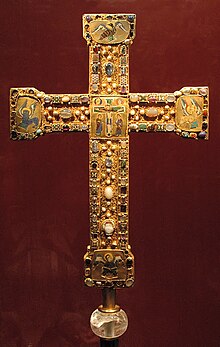Essen cross with large enamels


The Cross with large enamels, or Senkschmelz Cross, known in
Description
The original part of the cross is 46 cm high and 33 cm wide, with a core made of
The name of the cross derives from the five large pieces of senkschmelz enamel at the extremities of the members, and in the crossing. In the centre of the Cross there is a slightly oblong plaque with a depiction of the crucifixion:
At the ends of the members of the cross, inside a simplified border of gemstones, which matches the border of the cross' arms, four further large, irregularly shaped senkschmelz panels are found with the
. These large senkschmelz panels are unusually large for European work (as opposed to Byzantine) and of high technical and artistic quality, which is visible in the rich colours and fine delineation of the wings.The back plate of the Cross was replaced in the twelfth century and depicts the
Creation and remodelling
The Cross is universally dated to around 1000 by scholars.[3] This dating is based firstly on the motifs of the 21 small enamels of the border, which bear floral and carpet-like patterns, which arose around the turn of the millennium, and secondly on the framing of the stones and border enamels which seems to derive from the Cross of Otto and Mathilde (dated to around 982).
The irregular form of the Evangelist plaques is conspicuous, as is the fact that the central plaque does not fit neatly to its position. These plaques were created around 1000.[1] However, on the grounds of their similarly irregular shape, these plaques were probably created for another context and later incorporated into the Cross, which was considerably altered as a result. For this purpose, the plaques of the Evangelists, whose composition betrays Byzantine influence, were recut.[4] Therefore, their irregular shape stressed the fact that they were spolia.[5] In order to fit these plaques, the original border of the ends and centre of the Cross was simplified to the current form.
Beuckers dated this remodelling to the time of
If this dating is accepted, then the Cross with large enamels was created at the same time as the
History
From its creation, the cross has been located in Essen, except for evacuations during wars and other crises. Because of the similarities with the two other crosses of the Cathedral Treasury, which show Mathilde and were also donations to Essen, it is assumed that it belonged to the Abbey continuously from its donation until the
At secularisation the Catholic
In the
With the creation of the
Liturgical use
Details of the original liturgical use of the Cross are not known. When the sources, most importantly the Essen Liber Ordinarius of 1400, describe the use of processional crosses for processions, they speak generally and without distinguished individual crosses. Processional crosses were often used in pairs and on the basis of the creation of the Cross with large enamels under Abbess Mathilde it is assumed that the Cross with large enamels was made as a companion to the Cross of Otto and Mathilde. The two crosses were used together under Cardinal Hengsbach. The Cross with large enamels was last used in 1992 at the funeral of the second Bishop of Essen, Dr. Hubert Luthe. Today the Cross with large enamels, like the other three Ottonian processional crosses of the cathedral, is no longer in use for conservation reasons.
References
Notes
- ^ a b Beuckers, Farbiges Gold, p. 10.
- ^ On a young lion and a cobra you will tread; you will trample the young lion and the serpent.
- ^ Beuckers, Marsusschrein, p. 112 (with further references).
- ^ Beuckers, Farbiges Gold, p. 8.
- ^ Beuckers, Farbiges Gold, S. 11.
- ^ Beuckers, Marsusschrein, p. 112.
- ^ Beuckers, Marsusschrein, p. 117.
- ^ The inventory is reproduced by Humann, Die Kunstwerke der Münsterkirche zu Essen, pp. 34–35.
- ^ Lydia Konnegen, "Verborgene Schätze. Der Essener Münsterschatz in Zeiten des Ruhrkampfes." in Münster am Hellweg 58, 2005, pp. 67–81.
Sources
- ISBN 3-402-06251-8.
- Klaus Gereon Beuckers. "Kreuz mit den großen Senkschmelzen." In Gold vor Schwarz – Der Essener Domschatz auf Zollverein, edited by ISBN 978-3-8375-0050-9, p. 70.
- Klaus Gereon Beuckers, Ulrich Knapp. Farbiges Gold – Die ottonischen Kreuze in der Domschatzkammer Essen und ihre Emails. Domschatzkammer Essen 2006, ISBN 3-00-020039-8.
- Georg Humann. Die Kunstwerke der Münsterkirche zu Essen. Düsseldorf 1904.
- Lydia Konnegen. "Verborgene Schätze. Der Essener Münsterschatz in Zeiten des Ruhrkampfes." Münster am Hellweg 2005, pp. 67ff.
- Alfred Pothmann. "Der Essener Kirchenschatz aus der Frühzeit der Stiftsgeschichte." Herrschaft, Bildung und Gebet – Gründung und Anfänge des Frauenstifts Essen. Klartext Verlag, Essen 2000, ISBN 3-88474-907-2.
External links
 Media related to Kreuz mit den großen Senkschmelzen (Essen) at Wikimedia Commons
Media related to Kreuz mit den großen Senkschmelzen (Essen) at Wikimedia Commons
